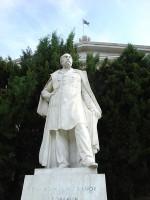
The National Library: The Statue of Panaghis Vallianos
Thanks to his donation, the erection of this building was possible. Vallianos was a merchant born in Kefallonia and during the Crimean War he became rich. In 1858 he moved to London, where he established and developed new business activities in commerce and banking, with remarkable financial results. Besides this building, he financed many projects in Kefallonia. |



